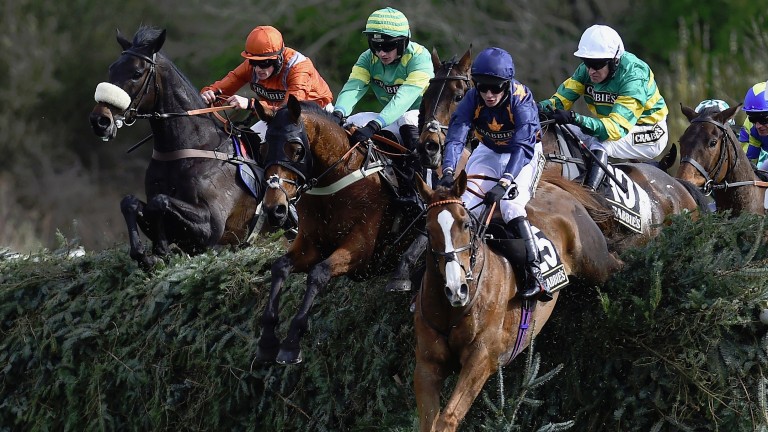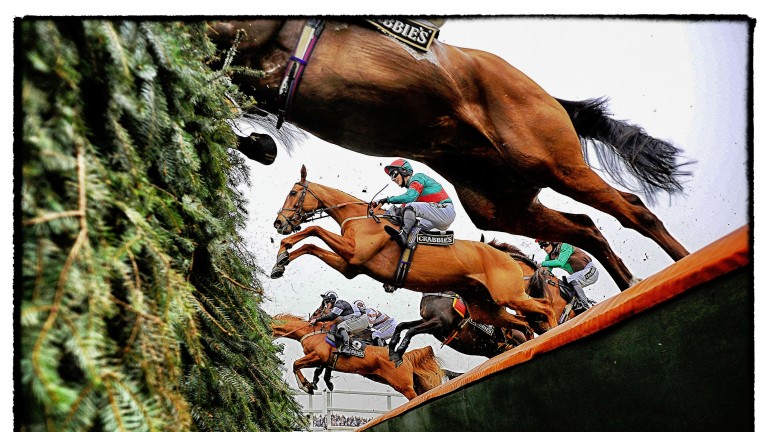THE GRAND NATIONAL FENCES

Runners must navigate two laps of the unique 2m2f course, tackling 30 of the most testing fences in National Hunt racing. This is the Racing Post guide to the Grand National fences.
The Grand National fences are without doubt the most iconic obstacles in horseracing. During the Grand National, 40 jockeys and horses will attempt to negotiate the 30 fences over 4m2½f during the two circuits, posing a thoroughly unique test to both horse and rider. But the National isn’t the only race to be run over the famous fences, as the Becher Chase and Grand Sefton Chase are both run in December, and the Foxhunters’ and the Topham take place on the Thursday and Friday of the Grand National meeting.
Changes to both entry restrictions and the fences themselves have been made in recent years, but the magnitude of the historic race remains the same.
Fence 1 & 17: plain fence
The infamous cavalry charge to the first can often result in chaos for a few, even though the first fence is one of the smallest on the course. You have to go back to Auroras Encore’s win in 2013 for the last time all the runners made it over the first. Following the 2012 race, the landing side of the fence was reduced.
Fence 2 & 18: plain fence
The second fence is slightly bigger than the first, but again is a standard spruce obstacle.
Fence 3 & 19: open ditch
Daunting in appearance, the third fence has an open ditch spanning 1.83 metres, as well as a drop on the landing side. Jockeys will aim to get their horse’s hocks underneath them so they have the power to clear it cleanly.
Fence 4 & 20: plain fence
Fence four is the same height as fence three but without the ditch.
Fence 5 & 21: plain fence
Fence five, known most commonly as ‘the fence before Becher’s’, is actually identical in height to Becher’s, but with a lesser drop on the landing side. Jockeys may chose to drift out wider here in preparation for the next fence.
Fence 6 & 22: Becher’s Brook
Named after Captain Becher, who fell at this fence in the first ever Grand National and hid in the water on the landing side of the fence as the other runners jumped over him, Becher’s Brook is one of the landmarks of the Grand National. Often riders choose to jump it towards the centre, as the drop is not as steep as the outside of the fence. The fence itself is 1.52 metres tall, with the landing side dropping 15 centimetres. This often causes problems, and if a horse lands too steeply it can peck or crumble on landing as its momentum carries it downwards.
Fence 7 & 23: Foinavon
Another key characteristic to the Grand National course is the fence named after Foinavon. Unlike Becher’s Brook, Foinavon is one of the least imposing obstacles on the course, standing at just 1.37 metres. The fence’s namesake came about due to a colossal pile-up in the 1967 Grand National, where John Buckingham, aboard 100-1 no-hoper Foinavon, was so far behind he managed to avoid the chaos and go on to win. The fence also precedes one of the most unique tests on the course, so often it can be jumped out quite wide. Horses can make errors here after acclimatising to the demands of Becher’s.
Fence 8 & 24: Canal Turn
The Canal Turn is one of the most tactically demanding challenges horse and jockey face throughout the Grand National. Because Foinavon is such a small fence, jockeys can afford to prepare for the Canal in advance. The sharp, 90-degree turn means it is an advantage to jump it from the outside and cut across to save valuable ground. Most people aren’t aware but there was a ditch in front of this fence until 1928.
Fence 9 & 25: Valentine’s Brook
Valentine’s stands at 1.52 metres with a 1.68 metre brook. Originally referred to as the ‘second brook’, the name change was courtesy of Valentine, a horse who appeared to jump the obstacle hind-legs first in 1840. There was momentarily a grandstand alongside this fence, but it was demolished in the 1970s.
Fence 10 & 26: plain fence
A fence standing at 1.52 metres. The canal runs alongside.
Fence 11 & 27: ditch
This fence is exactly the same height as the previous fence, but with an additional 1.83 metre ditch on the landing side.
Fence 12 & 28: ditch
Again this fence is 1.52 metres in height, with a 1.68 metre ditch. After jumping this obstacle, the runners cross the Melling Road, a key feature of the National which on the second circuit signals the race is really coming to the boil as the runners join the main circuit of the racecourse.
Fence 13 & 29: plain fence
This fence comes following the Melling Road where horses have been allowed a quick breather before the final run to the finish. It is also one of the smaller fences on the course, and rarely causes problems.
Fence 14 & 30: plain fence
The final fence on the second circuit is marginally smaller than the obstacle before it, and although horses are often tired when they reach it, it normally doesn’t have much impact on the finish. One notable faller was Hedgehunter, who was close-up and disputing third when he fell at the last in 2004 when Amberleigh House went on to win. The following year he made amends and won. After the last the runners make their way up the famous ‘elbow’ where fortunes can change right up to the line.
Fence 15: The Chair
One of the most fearsome fences on the course, The Chair provides racegoers with a fantastic spectacle. It is named so because the judge who determined the distances between each horse once sat parallel to it. The fence is 1.57 metres in height and has a 1.83 metre ditch in front of it. There is a 15 centimetre rise on the landing side of the fence, meaning essentially it is the opposite of Becher’s. This shows how adaptable horses have to be to win the Grand National.
Fence 16: The water jump
After The Chair, horses and jockeys are allowed some momentary respite before they go out on to the second circuit to do it all again. The water jump is a mere 76 centimetres in height and doesn’t take as much jumping, but often horses may be seen to drag their hind legs and make a splash, which can unbalance them and cause them to lose momentum and ground.

